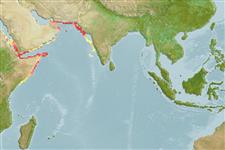Klassifizierung / Names
Namen | Synonyme | Catalog of Fishes(Gattung, Arten) | ITIS | CoL | WoRMS | Cloffa
>
Perciformes/Serranoidei (Groupers) >
Serranidae (Sea basses: groupers and fairy basslets)
Etymology: Chelidoperca: Greek, chelidon, -onos = swift, as black as a swift + Greek, perke = perch (Ref. 45335).
Environment: milieu / climate zone / depth range / distribution range
Ökologie
seewasser demersal; tiefenbereich 180 - 320 m (Ref. 124614). Tropical
Western Indian Ocean: Arabian Sea, including west coast of India, Pakistan, the Gulf of Oman, and off Socotra Island near the mouth of the Gulf of Aden.
Size / Gewicht / Alter
Maturity: Lm ? range ? - ? cm
Max length : 12.2 cm SL Männchen/unbestimmt; (Ref. 122102); max. veröff. Gewicht: 3.60 g (Ref. 122102)
Found usually on continental shelf and slope muddy bottoms and caught by bottom trawl (Ref. 114767).
Life cycle and mating behavior
Maturities | Fortpflanzung | Spawnings | Egg(s) | Fecundities | Larven
Manilo, L.G. and S.V. Bogorodsky, 2003. Taxonomic composition, diversity and distribution of coastal fishes of the Arabian Sea. J. Ichthyol. 43(suppl.1):S75-S149. (Ref. 52753)
IUCN Rote Liste Status (Ref. 130435)
Bedrohung für Menschen
Harmless
Nutzung durch Menschen
Tools
Zusatzinformationen
Download XML
Internet Quellen
Estimates based on models
Phylogenetic diversity index (Ref.
82804): PD
50 = 0.5010 [Uniqueness, from 0.5 = low to 2.0 = high].
Bayesian length-weight: a=0.00490 (0.00200 - 0.01202), b=3.12 (2.91 - 3.33), in cm total length, based on LWR estimates for this (Sub)family-body shape (Ref.
93245).
Trophic level (Ref.
69278): 3.6 ±0.5 se; based on size and trophs of closest relatives
Widerstandsfähigkeit (Ref.
120179): mittel, Verdopplung der Population dauert 1,4 - 4,4 Jahre. (Preliminary K or Fecundity.).
Fishing Vulnerability (Ref.
59153): Low vulnerability (10 of 100).
